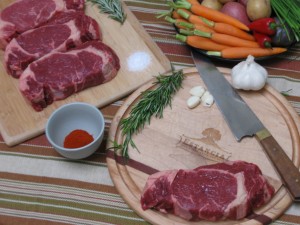The Souvenir Menu: Estancia Beef at Central Market’s “Passport Argentina”
May 12 through the 25th, Central Market held its “Passport Argentina” event, featuring a wide variety of produce, guest chef cooking demonstrations, and even tango demonstrations.
 I had the real pleasure of meeting Bill Reed, CEO of Estancia Beef, a new meat supplier to Central Market. Bill’s company provides free range, grass-fed beef from Argentina, Uruguay, Virginia, and California to markets in Europe and an expanding number of restaurants and markets in the United States.
I had the real pleasure of meeting Bill Reed, CEO of Estancia Beef, a new meat supplier to Central Market. Bill’s company provides free range, grass-fed beef from Argentina, Uruguay, Virginia, and California to markets in Europe and an expanding number of restaurants and markets in the United States.
Bill is from a third generation cattle producing family in Virginia. His uncle has been producing organic grass-fed beef and other organic produce for over 20 years. After a few jobs in the food industry in the U.S. and Europe, Bill partnered with childhood friend and fellow rancher JP Thieriot in 2006 to create Estancia Beef.
In our brief conversation, his genuine passion for the integrity of his products and the good it can do is evident. The possibility of providing better food was strongly coupled with the desire for a better quality of life for the animals raised.
I had heard about the virtues of grass-fed beef through Slow Food presentations and in various articles, but was not aware of how contentious the issue was until I started doing research for this article. Reading some of the opinions online was like reading logger vs. “tree hugger“ blogs and op-ed pieces.
In this case, the issues were the harsh, modern cattle industry practices that provide the majority of beef in this country and the newer trend to return to more sustainable and a far less manipulated product.
The grass-fed movement has its roots in a back-to-basics ideology. In the early decades of the 1900’s, the majority of beef produced in the U.S. was grass-fed. In the ensuing decades, the cattle industry’s need to fatten animals more quickly and economically led to far less open range cattle raising, high grain feed-supplements, and, at its extreme, small pen “feed-lot” raising of cattle. Growth hormones and antibiotics are also used to speed the growth of the cattle and to help the animals digest their modified diet.
Similar to the arguments for healthier organic fruits and vegetables, some beef producers are going back to slower, more natural processes in the raising of cattle. In the case of Estancia, the benefits are a more humane life for their cattle and the production of beef with half the fat and cholesterol of standard beef, and with higher natural levels of Omega-3 fatty acids.
Beef consumption in the United States has been relatively steady over the last decade. Leaner, more natural beef products with more sustainable agricultural practices are welcomed by those of us that still love a good steak.
Towards the end of our interview, I asked Bill about what an average meal in Uruguay / Argentina would be like. He said simplicity, but with great flavor, good bread, and big knives.
Per his advice last night, I cooked a couple of Estancia ribeyes using only sea salt to season, and a little chimichurri sauce on the side for contrast. I paired it with boiled potatoes with butter, salt and pepper, and a simple green salad with oil and vinegar. With a crusty french bread and a good Malbec, it all made for a fantastic dinner.
Because grass–fed beef is leaner, a little more care is needed in preparation; higher initial heat and a generally lower heat for the finish will yield a tender steak. The flavor was pure nostalgia. Having grown up in South Texas with access to free range beef, the flavor of the Estancia beef took me back 30 years to my grandmother’s table. I couldn’t think of a better compliment.
By Richard ArebaloEstancia Ribeyes with Chimichurri
Total time: 1 hour. Serves 4.
The clean flavor of grass fed beef combined with a fresh blend of herbs makes for a beefy steak that feels like a light meal.
Steaks
4 Ribeye grass fed steaks, 10 - 12 oz.
Sprinkle the steaks with coarse salt and a touch of pepper. Use a hardwood or charcoal grill for best results. Start over hot coals and move to lower heat until medium rare. Let rest for 5 minutes before serving.
Chimichurri sauce
1 cup of fresh flat leaf parsley
1 cup of fresh oregano
4 cloves of garlic, peeled
1 teaspoon of red peppers flakes
1 cup of water
1 tablespoon of sea salt
½ cup of extra virgin olive oil
¼ cup of red wine vinegar
Mince and combine the parsley, oregano, garlic and pepper flakes into a bowl. Mix in the water and salt and let rest for 30 minutes. Add the vinegar and olive oil, and mix well. Store overnight in a cool place in a sealed jar. The sauce can last a few weeks if refrigerated.








Completely agree. However I don’t think that is the end of the story. Visit beef online. Can’t wait to hear more. Kudos. Loved the post. I wish there was more to read.